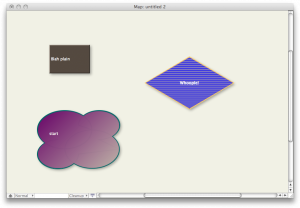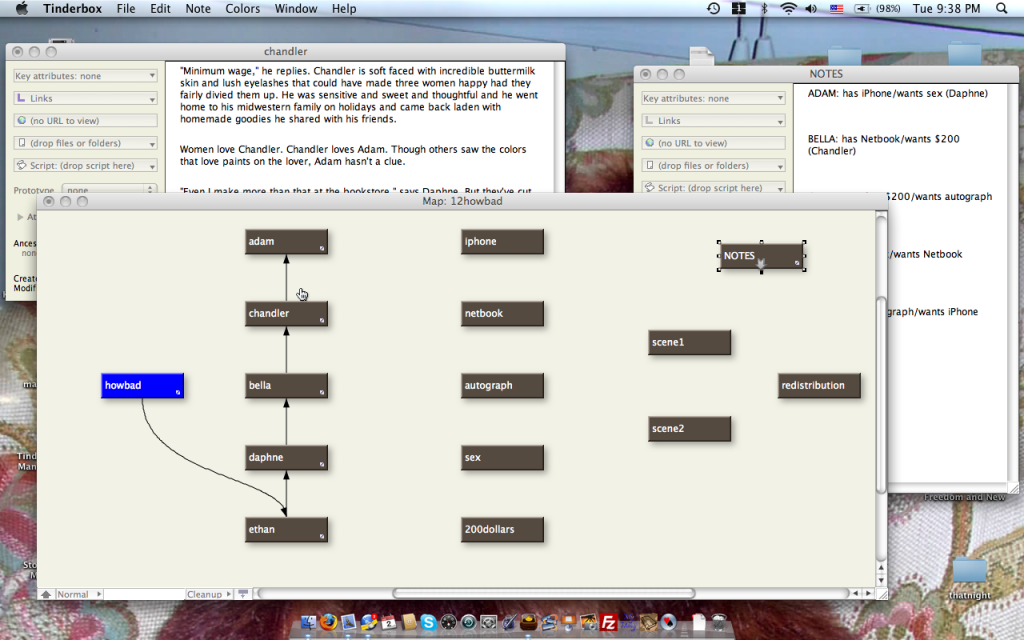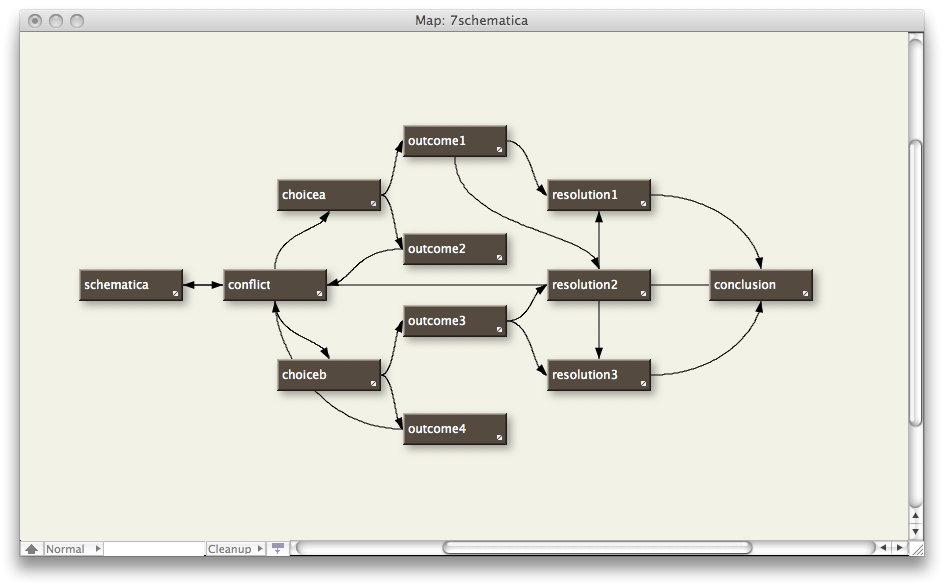Archive for the ‘TINDERBOX’ Category
Saturday, June 6th, 2009
 For goodness’ sake I didn’t realize that I could make different shapes and all kinds of good stuff with the plain little note boxes in Tinderbox.
For goodness’ sake I didn’t realize that I could make different shapes and all kinds of good stuff with the plain little note boxes in Tinderbox.
Hot damn.
These hypertext-a-day stories are going to take me three times as long now; I just had to play with color for the actual finished export before I got down to the business of narrative, linking, and mapping. Looks like I may be running behind.
Tags: 100 DAYS PROJECT, HYPERTEXT, TINDERBOX
Posted in 100 DAYS PROJECT, HYPERTEXT, TINDERBOX | Comments Off on TINDERBOX: Oh my!
Tuesday, June 2nd, 2009
With a couple hours’ of a deadline that won’t get me tossed out of the group if I miss it but is Catholic nun-influenced and ingrained anyway, I’m finding that the organization of Tinderbox is excellent for this 100 Day Project. I’ve started using notes for notes on story characters that are critical and complicated in this particular piece. Just as I’ve found myself planning and setting up writing spaces (vaguely as short sequences that I’ve come to learn is a hypertext way of writing story), I’ve set up maps of the spaces laid out as I think they would best be presented. Of course these aren’t unidentified blank spaces; indeed, they are titled to identify the concept, though they are also indeed very blank (though at this point I’m really about halfway through filling them in).
Here’s a screenshot of my work in progress:

Tags: HYPERTEXT, TINDERBOX
Posted in HYPERTEXT, TINDERBOX | 4 Comments »
Friday, May 29th, 2009
Just because it’s a first for me–mapping out the entire narrative before even writing a word or knowing what the story would be–I’m posting this image of the map that was laid out in Tinderbox for hypertext story #7, Schematica.

It is an example of the simplest plotting in story, with the required conflicts, complications, and required choices–whether made by the protagonist in traditional text or by the reader in hypertext.
Mimicking the “You’re dead!” of the Interactive Fiction and gaming genres, I’ve included a deadly choice (Outcome2 and Outcome4) here but have given the reader the ability to go back to the point where that choice was made to enable a change of heart. The main purpose of this piece was to follow Steve’s lead in following story guidelines, so the map was easy enough to lay out with lexias that were clear enough in what they would contain. Then all it took was to decide what time period, place, and characters would fill in the spaces.
Tags: 100 DAYS PROJECT, HYPERTEXT, TINDERBOX
Posted in 100 DAYS PROJECT, HYPERTEXT, TINDERBOX | Comments Off on HYPERTEXT and 100 DAYS PROJECT: Mapping of Schematica
Monday, May 25th, 2009
Well I’ve finally gotten the setting up of the stories in Tinderbox and their export here down to a science; the last story went through without a hitch. I even managed to put in the return link to the flash fiction page without having to do it on the server.
So the technical, the really technical portion of the project is somewhat under control. The story part is neat because I’m just letting stuff roll out of my mind. The problem I’m still having is the hypertext form itself. Even with as little as under ten lexias I’ve not gotten the knack of returns for emphasis, and maneuvering the reader through every lexia. I just reread the last story and got spit back at the home page without reading the majority of the work. This would be fine if the story was complete and satisfying with just those portions read, but it definitely indicates a lack of control as an author if it doesn’t.
Since I’m caught up, I might just spend some time tonight retesting and relinking.
Posted in HYPERTEXT, TINDERBOX | Comments Off on HYPERTEXT and TINDERBOX: Learning More
Monday, May 25th, 2009
Well, I know what I’ve been doing wrong with the story exports and it was the case of the duplication of the story file name, or else the lack of entering it into the Tinderbox html instructions for the URL.
So I’ve now gotten two stories into Tinderbox and out onto the Flash Fiction Page and am halfway through the third. Though I’m not participating in the 100 Stories Project, I’ve found that if I can follow along I can learn much, much more that I need to know about story written in hypertext and the thought process behind the linking, as well as the workings of the Tinderbox program that instead of being afraid, I can begin to settle into it.
Tags: HYPERTEXT, TINDERBOX
Posted in HYPERTEXT, TINDERBOX | Comments Off on HYPERTEXT and TINDERBOX: Learning
Sunday, May 24th, 2009
Hey Mark–I did it!
I’m not sure what was causing the problem in exporting, but it was obviously something I was doing wrong in the html URL that I was putting in there. First I went back through all my files and deleted all the duplications and test files to keep one clean copy. Then I emptied out all the folders except the very basics: story title folder under the project folder, and put only the css sheet, the tinderbox hypertext, and the html. In Tinderbox, I took each story out of the Projects and working with one, gave it its own separate file. Then exporting the program to its own folder worked.
From there it was just a matter of keeping the URL correct for the export process, and I found a duplication of “backups” in the /uploads/100stories/backups/1backups/file.
Tags: HYPERTEXT, TINDERBOX
Posted in HYPERTEXT, TINDERBOX | Comments Off on TINDERBOX: Export Successful
Saturday, May 23rd, 2009
It seems that I’m constantly updating Tinderbox to the latest version and this time I noticed that-ohmygosh!–I only have a month remaining on my free upgrades.
It’s taken me a while to warm up to Tinderbox and yet I can see that it will serve as one of my most valuable programs over the long haul. Right now I’m creating some short-short hypertexts in it just to get used to the basics and to feel out some of the possibilities. The visual display of containers and colors, as I’ve mentioned before, will prove to be very handy in tying in a group such as a series of hypertext stories that are separate yet related in some way. This is what I’m experimenting with right now and I’ve already gone back and changed things around a bit as new situations develop. But Tinderbox is flexible that way, and no motions are wasted as the arrangements are changed to suit a different scenario.
In a few days, I hope to upload and link these examples.
Tags: HYPERTEXT, TINDERBOX
Posted in HYPERTEXT, TINDERBOX | Comments Off on HYPERTEXT and TINDERBOX: Updating
Tuesday, May 19th, 2009
Learning for me has always been easiest in the doing. Instructions are held aside and come into play when a need arises that can’t be figured out by clicking buttons, turning screws, guessing, or the real motive of comprehension as to how something would logically work. But I’m also hampered by a stubborn resistance to change.
That said, when I fell in love with Storyspace as a means to write hypertext story, it was a pita to relearn and rewrite into Tinderbox even though the two are very similar in many ways in the processing and theory of linking. Tinderbox offers a world more of capabilities and the visuals of mapping and layout are more open and yet precise in the graphics. I’ve been fiddling around with several projects in Tinderbox, starting from placing a few short hypertext stories into a project space and from there transferring a much larger Storyspace piece into the medium, and progressing to a new project for a longer novel to make use of the research and note-making spaces that would act as an outline or rough plotting structure for the narrative. Even though I don’t know if this is going to in fact be a hypertext work, the concept of having it take shape in a more cohesive manner than pages of scribbled notes (I’ve never been an outline person, except to make the required one for teachers’ purposes after a story or essay was finished) is something that at this stage of my life offers invaluable assistance in saving time alone.
What’s nice about technology and the tools that software offers is that even with manuals and thick text of instructions, a user can always maneuver within the simplest form that suits his own needs, knowing that should more arenas of possibility open up, the field is there.
Tags: HYPERTEXT, STORYSPACE, TINDERBOX, WRITING
Posted in STORYSPACE, TINDERBOX, WRITING | Comments Off on WRITING: Planning with Tinderbox
Saturday, May 9th, 2009
While focusing what brain power I had available in the last two weeks on linear story in another attempt to meet deadlines of lit journals, I’ve done little in the hypertext department except to put a story or two into the Tinderbox environment to compare it to the way I’ve done the same with Storyspace. I have found a funner way to work in Tinderbox, by using the colored box changes as a visual allure. Something I’ve always liked about Storyspace–particularly the Mac version–is the crisp graphics of the screens that you write into. It inspires by enhancing the tone. Tinderbox can work similarly, though I’ve not yet found the connection between Notes besides as they might contain a single story within and those Notes connected as lexias in typical hypertext narrative form. The individual stories themselves right now do not seem to have a connection but I can easily see how Tinderbox would be the more useful program in which to both make the connections, and yet provide the containers to separate them into their individual selves.
Twiddling a little with it then, but won’t be able to put more time into it until the lit journals have closed for the summer and I’ve no rational excuse to put it off.
Tags: HYPERTEXT, STORYSPACE, TINDERBOX
Posted in HYPERTEXT, STORYSPACE, TINDERBOX | Comments Off on HYPERTEXT: Story and Software
Thursday, February 12th, 2009
Steve Ersinghaus has been working on a poem in Tinderbox and has added stretchtext features using jQuery within the boxes. Read about the process he’s been willing to share.
Tags: NEW MEDIA, TINDERBOX
Posted in NEW MEDIA, TINDERBOX | Comments Off on TINDERBOX: And Poetry
 For goodness’ sake I didn’t realize that I could make different shapes and all kinds of good stuff with the plain little note boxes in Tinderbox.
For goodness’ sake I didn’t realize that I could make different shapes and all kinds of good stuff with the plain little note boxes in Tinderbox.


 The Lost Children: A Charity Anthology
The Lost Children: A Charity Anthology